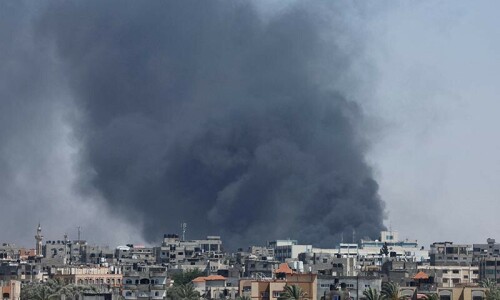
KARACHI, May 31: “We were shocked and overwhelmed with grief when the doctor broke the news that our daughter is suffering from blood cancer. In fact, we got so upset by the disclosure that we refused to get treatment at the hospital and headed back home,” reminisces Farzana Ramzan, a mother of three.
Umme Habiba, Farzana’s nine-month-old daughter, is currently the youngest cancer patient at the Children Cancer Hospital (CCH), the country’s only health facility dedicated exclusively to treat cancer in children.
The infant who suffered from chronic diarrhoea and was treated at a government hospital before being referred to the CCH had been diagnosed with blood cancer 20 days ago.
“The doctor repeatedly called and warned us that the disease could spread and endanger Habiba’s life if we delayed her treatment. So, we brought her to the hospital the next day,” she says.
The other major factor that convinced the family to seek cancer treatment was the hospital’s policy to offer free treatment to those who are less privileged.
The family, originally hailing from Naushehro Feroze, lives in a rented house in Karachi and the daily earning is not more than Rs300.
The family seems to be satisfied with the treatment now as Habiba is recovering. “I can see the obvious improvement in her health. I don’t have to force her to eat any more and she is active, too,” she said.
Habiba shares her room with one-year-old Nadia, a liver cancer patient. She had fever, swollen tummy and developed some abnormal growth in the chest, according to her father Mohammad Aaru, who had come from Nawabshah along with her family for her daughter’s treatment.
“We are living in Khuda Ki Basti, New Karachi, on rent these days. My mother stays at home with my two sons while I and my wife take care of Nadia,” says Aaru while explaining that the family is surviving on borrowed money and whatever little he infrequently earns from daily labour.
Aaru is not alone to have put all his life’s assets at stake, just for the treatment of their child.
There is also Asif, who was forced to travel all the way from Herat, Afghanistan, to Karachi to seek treatment for five-year-old son Fahim, being treated for lymphoma cancer. The same is the case of Mohammad Abid, a lawyer from Quetta.
Abid had to quit his job a year ago and migrate to Karachi for the same reason. “I can practise in Karachi. But how can I work? My whole day is spent with my three-year-old daughter Nimra, who I bring here for follow-up visits for blood cancer treatment while my wife looks after the other child at home. So far, I have spent up to Rs700,000 on Nimra’s treatment as I refused to have the treatment on donations,” he said.
Giving information about infantile leukemia, Dr Syed Ahmer Hamid, consultant pediatrician and pediatric oncologist, said that the survival rate in cases of children less than one year was 40 to 50 per cent while in others it was 70 to 80 per cent.
Explaining the reasons for low survival rate in infants, he said that the infants couldn’t tolerate the intensive cancer treatment and could die from complications.
“The survival rate is low. But there is a chance. Without treatment, there is no chance,” he said, adding that the hospital had received a few neonates with cancer which was a very rare phenomenon.
Reasons for childhood cancer
No specific reasons have yet been identified for childhood cancer and they are still being explored, says Dr Ahmer. “Though nothing could be said with certainty, some studies underline the role of abnormal genes and certain infections while others say that it could be a combination of both genetic and environmental factors.”
The most common form of cancer was blood cancer, followed by cancer of the lymph glands, nervous system, eye, bones, etc. Only two to three per cent patients the hospital received suffered from liver cancer, he said.
The sign and symptoms of cancer, according to specialists at the CCH, depended upon the type of cancer the patient has.
However, at least 85 per cent of childhood cancer is associated with the following warning signs: unusual abnormal mass or swelling, prolonged and unexplained fever, loss of energy and rapid weight loss, unexplained and prolonged pain and headache, often with vomiting, easy bruises and unexplained bleeding, sudden change in balance or behaviour.
The presence of these signs and symptoms may occur in other diseases, but in cases these persist one should consult the doctor to exclude cancer, they said.











































Dear visitor, the comments section is undergoing an overhaul and will return soon.